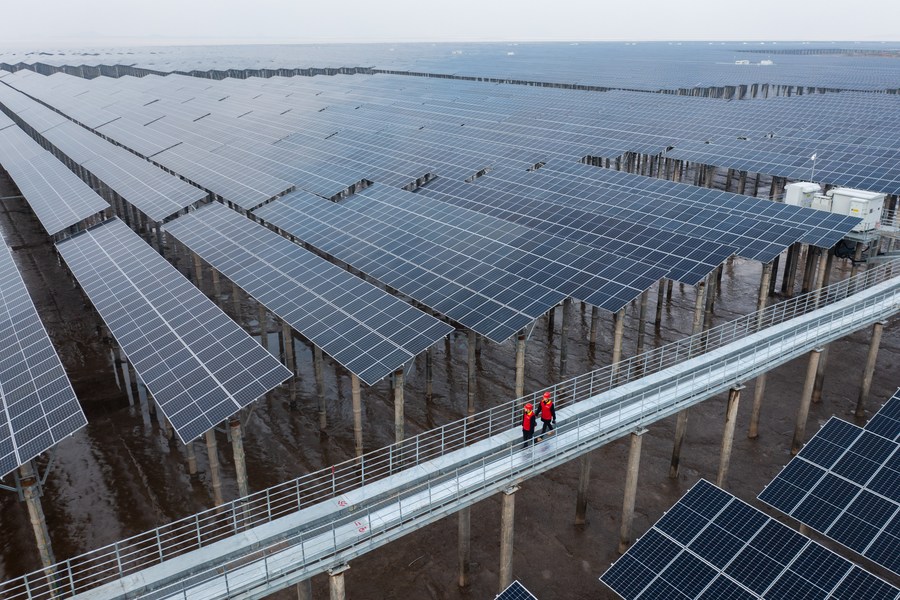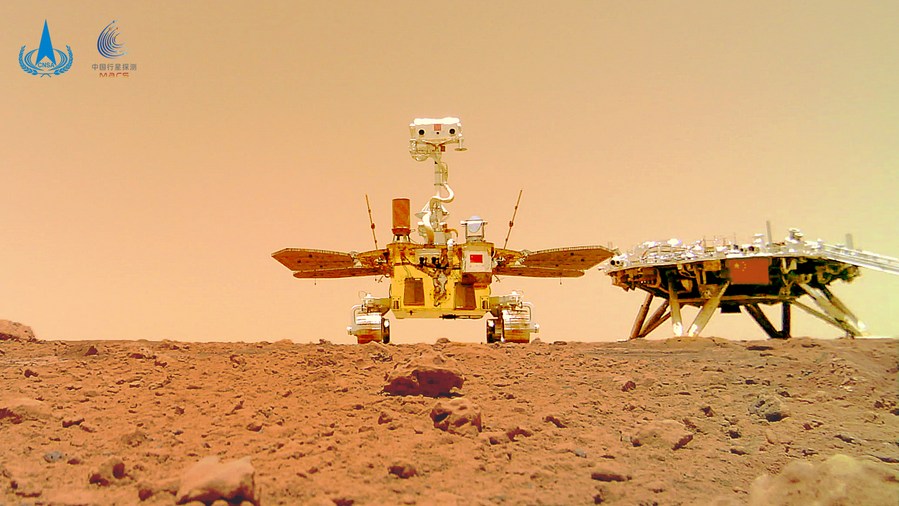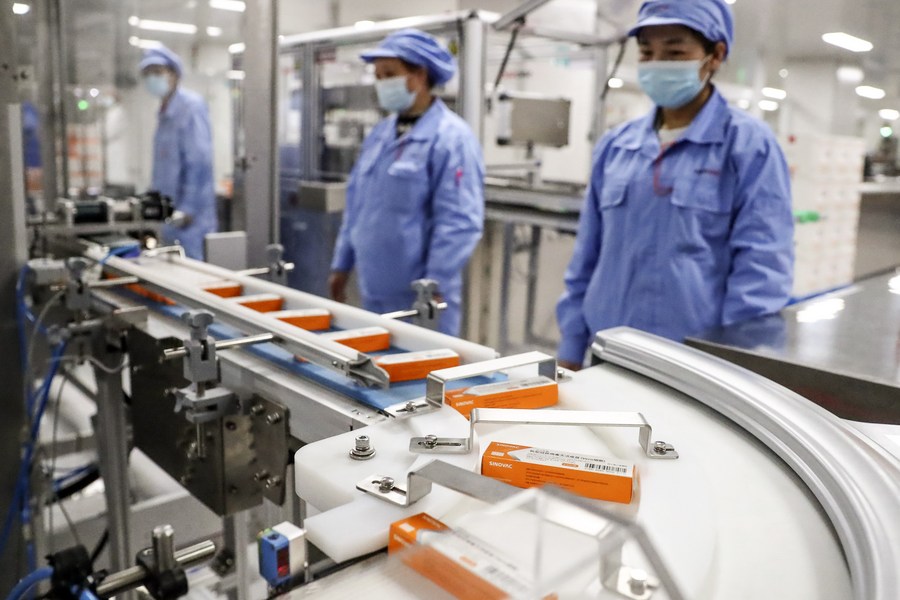A solidly modernizing China to chart blueprint for year 2022
* The annual sessions of China's top political advisory body and top legislature will soon convene.
* The gatherings are heavyweights in China's political calendar as the national agenda will be set for the year.
* This year the meetings carry extra weight as 2021 was a fresh start in China's new quest to build itself into a modern socialist country.

Aerial photo taken on Dec. 29, 2021 shows a photovoltaic power base in Xiangshan County, Ningbo City of east China's Zhejiang Province. [Xinhua/Xu Yu]
BEIJING -- As China, the world's second-largest economy, moves full steam ahead toward building a modern socialist country, the forthcoming "two sessions" will once again show to the world how the nation of 1.4 billion people strives to accomplish the goals.
The two sessions are the country's annual meetings of the National People's Congress (NPC), China's top legislature, and the National Committee of the Chinese People's Political Consultative Conference, the national political advisory body. The gatherings are heavyweights in China's political calendar as the national agenda will be set for the year.
This year the meetings carry extra weight as 2021 was a fresh start in China's new quest to build itself into a modern socialist country.
"The Chinese often say that we should win at the starting line. The year 2035 (the goal year to basically achieve socialist modernization) is not far away. We should seize every minute. And therefore it is even more critical to chart blueprints and answer questions of how to do it better at this year's two sessions," said Zhou Hanmin, a national political advisor from Shanghai.
ROBUST GROWTH
China remained a stabilizing anchor of the world economy in 2021, with its gross domestic product (GDP) growth at 8.1 percent -- the highest in around a decade.
Per capita disposable income in 2021 hit 35,128 yuan (about 5,545 U.S. dollars), an increase of 9.1 percent year on year in nominal terms.
The rising income is tangible for Liu Jianming, a deputy to the 13th NPC from Tangdi, a hilly village in east China's Zhejiang Province.
Liu, the village's Party chief, led locals to ride the wave of agritourism and made Tangdi a popular tourism destination for market gardening.
Now 95 percent of local residents are engaged in gardening-related industries, with per capita disposable income exceeding 110,000 yuan in 2021.
"Pinpointing a suitable industry is not enough to boost the economy in mountainous areas. We need talents to keep it prosperous," Liu said, admitting that even with rich planting experience, industrial upgrading remains urgent in Tangdi.
In the recently published "No. 1 central document" for 2022, the first policy statement released by China's central authorities each year, key tasks were outlined to comprehensively push forward rural vitalization this year.

Photo released on June 11, 2021 by the China National Space Administration (CNSA) shows a selfie of China's first Mars rover Zhurong with the landing platform. [CNSA/Handout via Xinhua]
DRIVEN BY INNOVATION
Stressing high-quality development, China has exerted great efforts in innovation, industrial upgrading and cutting-edge technologies.
China's spending on research and development (R&D) in 2021 rose 14.2 percent year on year to reach 2.79 trillion yuan, hitting a new high of 2.44 percent of its GDP.
Over the past year, China has made marvelous technological breakthroughs.
China's Mars probe Tianwen-1 made the landing on Mars in May, ushering in a new chapter of China's deep space exploration. In October, China launched the crewed spaceship Shenzhou-13, sending three astronauts to its space station core module Tianhe for a six-month mission.
Traditional manufacturing powerhouses quickened their pace of transformation paired up with a basket of facilitating policies. A legion of small but specialized enterprises have sprung up with greater visibility in cementing the country's industrial strength.
"Innovation will continue to be a keyword in promoting China's modernization," said Chen Liang, an associate research fellow at the Institute of World Economy, Shanghai Academy of Social Sciences. "I believe in 2022, China will further improve the innovation and entrepreneurship ecosystem and make new breakthroughs in scientific and technological innovation."

Staff members supervise the operation of an automated packing line for inactivated COVID-19 vaccine at Sinovac Life Sciences Co., Ltd. in Beijing, capital of China, on Jan. 6, 2021. [Xinhua/Lu Ye]
GOVERNANCE MODERNIZATION
The COVID-19 pandemic, over the past two-plus years, has been a barometer of governance effectiveness and China is undoubtedly among the best performers.
China's dynamic zero-COVID approach has provided maximum protection to the health of its people while minimizing the impact on their daily life and economic growth.
The annual two sessions, during which national lawmakers and political advisors offer wisdom on major issues, provide outsiders a good chance to understand how the country is run.
At last year's two sessions, the NPC adopted the amendments to two laws that concern its organization and working procedures: the Organic Law of the NPC and the Rules of Procedure for the NPC.
Wang Chen, vice chairman of the NPC Standing Committee, said amending the two laws is an institutional guarantee for upholding "whole-process democracy" and safeguarding the people's role as masters of the country.
ECOLOGICAL ENVIRONMENT IMPROVED
The year 2021 is regarded as "Year One" for China to move toward carbon neutrality, which witnessed the release of a top-level design document for peaking carbon emissions and achieving carbon neutrality and an action plan for peaking carbon emissions before 2030.
In 2021, the country's progress in cutting carbon dioxide emissions per unit of GDP met the 14th Five-Year Plan period (2021-2025) requirements. As the PM2.5 density went down 9.1 percent year on year, the share of days with good air quality rose to 87.5 percent.
The Yangtze River, China's longest river, also saw the water quality of its primary stream continue to improve.
Earlier in January, China rolled out a series of policies in terms of protecting the marine environment, preventing soil and underground-water pollution and protecting the rural environment, demonstrating its determination to make fundamental improvements in the ecological environment.

Photo taken on Feb. 4, 2022 shows a cauldron holding the Olympic flame during the opening ceremony of the Beijing 2022 Olympic Winter Games at the National Stadium in Beijing, capital of China. [Xinhua/Yang Lei]
GROWING CULTURAL EXCHANGES
The recent Beijing 2022 Olympic Winter Games was described as a "truly exceptional" event by the International Olympic Committee President Thomas Bach. The event, attracting global attention, was not only a grand event of ice and snow sports but also a precious opportunity to present China's culture to the world.
The over 5,000-year-old Chinese culture was integrated into every aspect of the Olympic Winter Games, making the event extraordinary, said Chen Ning, head of culture and ceremonies department of Beijing 2022 Winter Olympics organizing committee.
Through the Beijing Winter Olympics, China's commitments to building a community with a shared future for humanity have also struck a deeper chord with people worldwide.
"The opening and closing ceremonies presented a true, vivid, enthusiastic and culturally rich China to the world, which not only promoted world cultural exchanges but also brought new vitality to world culture," Chen said.
Reporting by Ma Yujie, Xia Xiao, Xu Xiaoqing, Yin Xiaosheng and Fang Wenyu; video reporters: Yin Nan, Li Cheng, Liu Zongya, Gao Wencheng; video editors: Zhang Yucheng, Luo Hui, Cao Ying and Zhu Jianhui
























